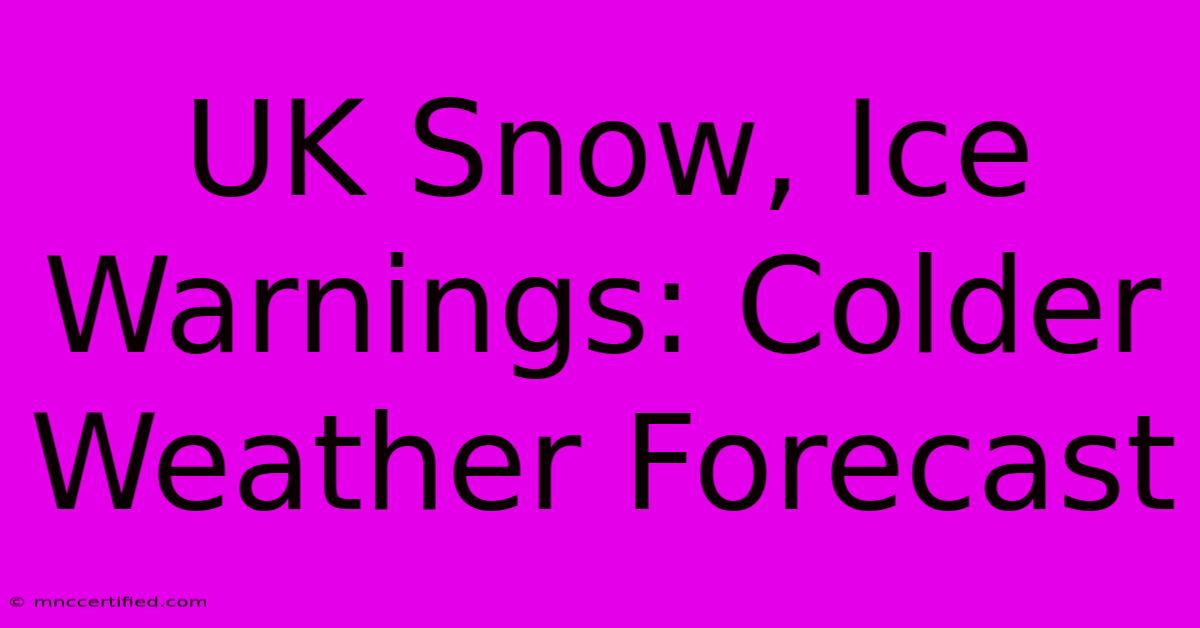UK Snow, Ice Warnings: Colder Weather Forecast

Table of Contents
UK Snow and Ice Warnings: Colder Weather Forecast
The UK is bracing for a potential wave of colder weather, with the Met Office issuing several snow and ice warnings across different regions. This article provides an in-depth look at the current forecast, areas affected, and crucial safety advice to help you stay prepared.
Current Weather Warnings and Affected Areas
The Met Office, the UK's national weather service, is responsible for issuing timely and accurate weather warnings. Currently, several yellow warnings for snow and ice are in place, primarily affecting:
- Scotland: Many areas of Scotland are expected to experience significant snowfall, particularly in the Highlands and Grampians. Travel disruption is highly likely.
- Northern England: Parts of northern England, including the Pennines, may see snowfall accumulating, potentially causing travel delays.
- Wales: Higher ground in Wales could also see some snow, although the impact is expected to be less severe than in Scotland and northern England.
It's crucial to check the Met Office website regularly for the latest updates and specific warnings for your area. Warnings are updated frequently as weather patterns evolve, so relying on outdated information can be dangerous. Search "Met Office weather warnings" on Google for the most up-to-date information.
Understanding the Met Office Warning System
The Met Office uses a colour-coded system to indicate the severity of weather warnings:
- Yellow: Be aware – potential for disruption.
- Amber: Be prepared – significant disruption likely.
- Red: Take action – severe danger to life.
Currently, yellow warnings are in place; however, this could escalate depending on the developing weather situation. Staying informed is paramount.
Preparing for Cold Weather and Snow
Being prepared for cold weather and potential snow is vital to ensure your safety and minimize disruption. Here’s a checklist:
- Check your travel plans: If you have travel plans, check for potential delays or cancellations before you set off. Public transport may be affected, and driving conditions could be hazardous.
- Stock up on essentials: Have enough food, water, and medications on hand in case you're stuck at home.
- Insulate your home: Ensure your home is adequately insulated to retain heat and reduce energy bills.
- Prepare your vehicle: Check your car's antifreeze levels, ensure you have a full tank of fuel, and pack a winter survival kit including blankets, warm clothes, and a shovel. Consider carrying winter tyres if you live in an area prone to heavy snowfall.
- Check on vulnerable neighbours: Make sure to check on elderly neighbours or anyone who may need extra assistance during cold weather.
Staying Safe on the Roads During Snow and Ice
Driving in snowy or icy conditions can be extremely dangerous. Here are some key safety tips:
- Avoid unnecessary journeys: If possible, avoid driving unless absolutely necessary.
- Drive slowly and carefully: Increase your braking distance significantly.
- Maintain a safe following distance: Allow plenty of space between you and the vehicle in front.
- Clear your car of snow and ice before driving: This ensures better visibility.
- Be aware of black ice: Black ice is transparent and difficult to spot, making it particularly hazardous.
Keeping Updated on the Forecast
For the most accurate and up-to-date information on the UK's snow and ice warnings and the broader weather forecast, always refer to the official Met Office website and their app. You can also follow them on social media for regular updates. Staying informed is the best way to stay safe during periods of severe weather.
This article aims to provide helpful information; however, it does not replace official weather warnings. Always prioritize official sources for critical weather information. Remember to stay safe and prepared!

Thank you for visiting our website wich cover about UK Snow, Ice Warnings: Colder Weather Forecast. We hope the information provided has been useful to you. Feel free to contact us if you have any questions or need further assistance. See you next time and dont miss to bookmark.
Featured Posts
-
Minor Quakes Reported Near Fontana
Nov 18, 2024
-
Nfl Raiders Vs Dolphins Odds Picks How To Stream
Nov 18, 2024
-
Harwood Bellis Impresses Keane On Debut
Nov 18, 2024
-
Raiders Vs Dolphins Game Odds Spread And Stream
Nov 18, 2024
-
Oregon Ducks Bluechip Linebacker Prediction
Nov 18, 2024